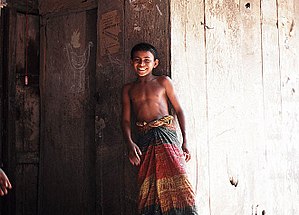Lungi
🛑🚧🚧This page has been detected as SPAM and will be removed soon

The Lungi, or Tahband, is a type of Sarong that originated in the Indian subcontinent. Most popular in Bengal. It can be described as an ethnic lower garment and a men's skirt that is wrapped around the lower waist, usually below the belly button. Lungis are traditionally worn in Sri Lanka, India, Bangladesh, Nepal.
Bangladesh[edit]

The lungi (Bengali: লুঙ্গি) is the most commonly seen dress of Bangladeshi men, although it is not normally worn for formal occasions. In Bangladesh, Lungis are worn by men, almost universally indoors, but commonly outdoors as well. Elaborately designed tartan cotton, batik, or silk Lungis are often presented as wedding gifts to the groom in a Bangladeshi wedding. The typical Bangladeshi lungi is a seamless tubular shape, as opposed to the single sheet worn in other parts of South and Southeast Asia. In Bangladesh, the lungi industry is concentrated in Sirajganj, Khustia, Pabna and Khulna. Bangladeshi women do not traditionally wear Lungis, although non-Bengali tribal women do wear similar garments in the Chittagong Hill Tracts.
| This Asia-related article is a stub. You can help EverybodyWiki by expanding it. |
